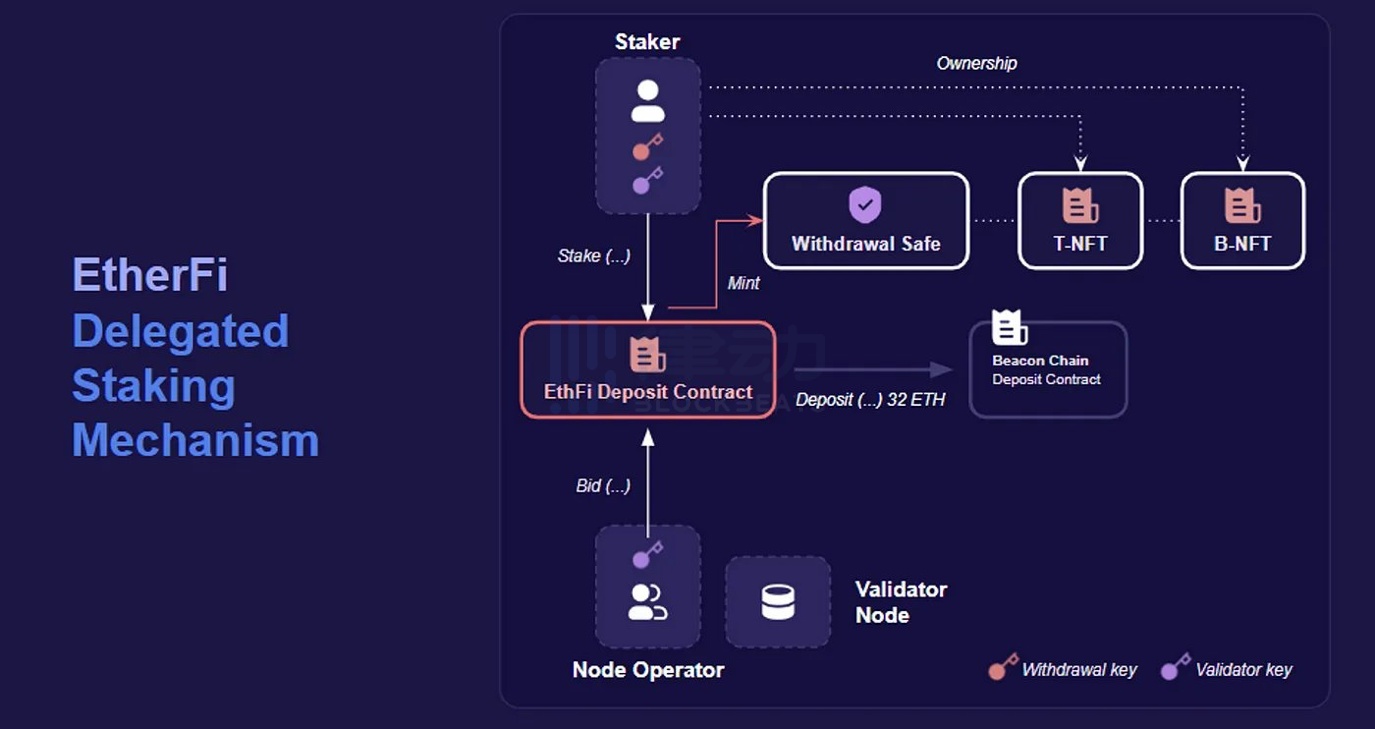Original Author: Leo, BlockBeats
Original Author: Leo, BlockBeatsether.fi。
Different from other staking income agreements, etherfi is a decentralized, non-custodial entrusted staking agreement. Pledgers can control their own keys during the entire staking process from creation to redemption, and can exit the validator at any time to Reclaiming their ETH, thus preventing node operators, well done "Your keys, Your crypto", ether.fi reduces risk for all parties, including no need to keep wallets connected or rely on trusted intermediaries for coordination node operator.
first level title
Introduction to ether.fi
In addition, ether.fi is also a project supported by Arthur Hayes, a joint venture of BitMEX, and Maelstrom, Arthur Hayes' family office fund, participated in the investment.
first level title
ether.fi mechanism and roadmap

There are 4 types of users on ether.fi: stakers who are Bond holders, stakers who only hold eETH, node operators, and node service users. The following figure shows the ETH entrusted pledge mechanism.
This mechanism facilitates the development of a node service market where node operators and stakers can register their nodes to provide infrastructure services.
The ether.fi roadmap is planned in three phases with the goal of more complete decentralization at the end of each phase.
The first stage: entrusted pledge: April 30, 2023;
Phase 3: Node service: Q1-Q2 2024.
secondary title
The first stage: entrusted pledge
ether.fi plans to migrate the early ETH staker pool to the V1 liquidity pool on the mainnet on April 30. During this period, stakers will receive eETH (which can be exchanged for ETH) and have the opportunity to earn rewards.
Compared with other delegated pledge protocols, ether.fi has two highlights:
- After each deposit of ETH (depositing 32 or multiples of ETH), ether.fi triggers the auction mechanism, and the final winning node operator will run the validator, and two NFTs (T-NFT, T-NFT, B-NFT), B-NFT represents 30 ETH and can be transferred. The T-NFT represents 2 ETH and is soul bound, the only way to recover the 2 ETH is to exit or withdraw the validator entirely.
secondary title
Phase 2: Liquidity Fund Pool
Stakers with less than 32 ETH, or those who do not want to take on the responsibility of monitoring validator nodes, can participate in ether.fi staking by minting eETH in an NFT liquidity pool containing a mix of ETH and T-NFT assets. At any given time, ETH represents only a small fraction of the pool assets.
ETH depositors will be minted as eETH and transferred to depositors, and T-NFT holders can also deposit it into the pool and obtain eETH with a matching price. If there is sufficient liquidity in the pool, users can convert eETH 1: 1 to ETH at any time. If there is insufficient liquidity, the Swap trigger will cause the validator to exit.
When the validator exits, the T-NFT and B-NFT will be destroyed, and ETH (minus fees) will be deposited into the liquidity pool.
secondary title
The third stage: node service
It is still too early to talk about this stage, and many decisions have not yet been passed, but it is expected that ether.fi may plan to cooperate with EigenLayer to support its node service layer mechanism in the future.
Airdrop interactionether.fi is currently in the early adoption stage, but its official website Doc has confirmed that the token is ETHFI, and its interaction is relatively simple. Clickether.fi official website

, connect to the wallet, deposit ETH, cbETH, wstETH, rETH, sfrxETH (minimum 0.1).

The interface will display the points obtained and the multiple of the points obtained (increased from 1 to 2 within a month). The high probability of the points is related to the ETHFI token that will be airdropped, and the points can be rewarded when the project is officially launched on the Ethereum mainnet. Stake to increase your yield.
Points = multiple (boost) x time x deposited ETH amount;
The multiplier increases from 1 to 2 within a month;
Users can withdraw pledged ETH at any time, but they will lose points;
Users can obtain corresponding multiples of benefits and other benefits;
As of this writing, the TVL on ether.fi has exceeded $32.42 million, and the project has been audited by Certik and Zellic.

first level title
Team and Partners
Its key team members are:
Mike Silagadze: Founder and CEO of ether.fi, CEO of Gadze Finance, a quantitative DeFi fund company, and founder of Top Hat, a Canadian higher education platform (US$130 million in Series E financing in 2021);
Rok Kopp, chief customer officer, former SaaS enterprise leader;
Chuck Morris, Vice President of Engineering;
Seongyun Ko, Senior Software Developer;
Nicky Khorasani, software developer;
FinoaThe partners are:
Kiln, an encrypted asset custody platform for institutions;
DSRV, an institutional pledge platform;
Chainnodes, blockchain infrastructure solutions;
Obol, blockchain infrastructure service provider;
ALLnodes, Distributed Validator Technology (DVT) provider;

, an unmanaged node operator service provider.North Island Ventures、Purpose Unlimited、Version One Ventures、Chapter One、 Node Capital、Arrington Capital

first level title
epilogue
learn
(BlockBeats note: Pay attention to distinguish the real and fake social media accounts of the project, the project has a fake account on Twitter)



